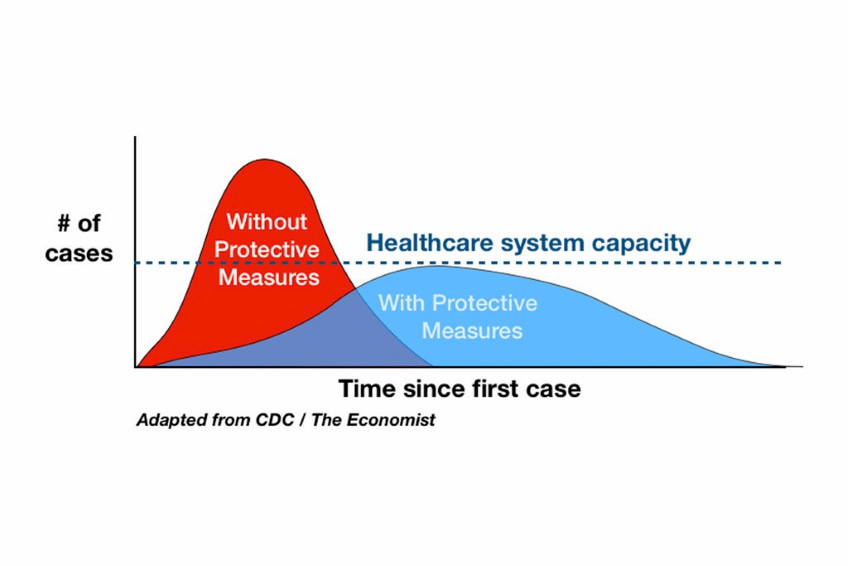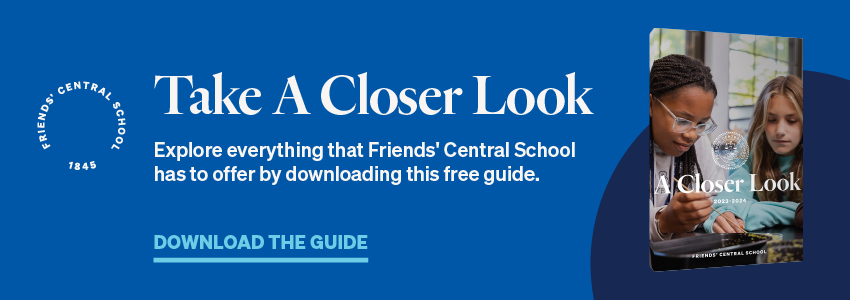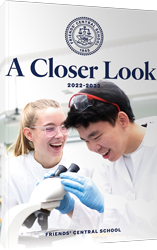%20Social%20Distancing%20for%20Schools.jpg?width=848&name=(Insert%20Feature)%20Social%20Distancing%20for%20Schools.jpg)
With the Coronavirus (COVID-19) currently rampaging around the globe, the news media cycle is essentially dedicated to delivering us a nonstop stream of grim statistics and an endless parade of experts discussing the steps everyone needs to take to keep themselves and their loved ones safe.
Already, the majority of states have taken steps to ensure their citizens stay home to stem the spread of the disease, and families have had to adjust to cancelled schools, working from home, and forgoing so many of the simple—but now forbidden—daily activities they had been used to enjoying.
Free Downloadable Guide: Take a Closer Look at Friends' Central School
Words like “quarantine” and “isolation,” which once seemed to exist only in science fiction movies, are everywhere, and adults and children alike are facing events that have never been seen before in living history. Because we have no frame of reference or prior experience to draw on, all our information comes from listening carefully to the experts and heeding the advice and directions of those who are leading us, with a simple desire of getting through the pandemic safely.
As a parent, the term “social distancing” is now likely dictating not only your daily life, but the lives of your family as well. A critical step in the fight against the spread of the pandemic, social distancing should be embraced by every family in an effort to keep themselves and their community safe. To ensure a successful social distancing campaign, parents should be sure both they and their children fully understand what the term really entails.
Below, we explore the term “social distancing,” why it’s so important, and offer some tips to help you get through social distancing with your family.
What is social distancing?
Social distancing refers to a set of practices designed to limit transmission of the Coronavirus. It works by limiting face-to-face interaction and physical contact with others as much as possible.
The term means slightly different things depending on who you are asking, so it’s important that you look to reputable and expert sources for guidelines. Organizations like the CDC and the American Red Cross provide clear, definitive instructions on successful social distancing, backed by the research and expertise of doctors, epidemiologists, and those who are actively studying COVID-19.
They outline the steps necessary to ensure social distancing, including including:
- Staying home as much as possible
- Staying at least 6 feet away from other people
- Staying away from crowded places
- Not gathering in groups
- Connecting with others virtually rather than in person
- Using delivery or take-out options rather than eating in restaurants
When individuals practice social distancing, they limit contact with infected people (even those who are otherwise asymptomatic) and the surfaces they may have contaminated. Silent carriers also limit the chances that they will infect others, particularly those who are immunocompromised or who have underlying health conditions who may experience worse symptoms of the virus.
This stops the virus from being able to spread and keeps those you might then transfer the virus to safe.
Why is social distancing important?
COVID-19 is spread when infected people cough, talk, or sneeze, releasing droplets from their nose and mouth into the air nearby and onto surfaces they may have touched. Social distancing limits contact with infected people and these contaminated surfaces, effectively stopping the spread.
In addition to hearing about social distancing, the term “flatten the curve” seems omnipresent right now, and with good reason. Flattening the curve refers to slowing or reducing the spike or increase in the number of COVID-19 cases so that our healthcare system can effectively treat those who are infected.
When charted on a graph, you can see the number of cases grow, often in an increasingly small amount of time. In many areas, cases may begin to double or quadruple each day or two without intervention.
However, scientists and experts are also able to project what that graph will look like with preventative measures, like social distancing. On this projection, the virus spreads slower, which avoids overtaxing resources like hospital capacity and supplies, allowing those infected to receive better and more comprehensive treatment.
The chart below, created by the New York Times and adapted from the CDC, demonstrates how this works:

Michelle Crowley, Director of Athletics and Wellness at Friends’ Central, likes to point out, though, that the term ‘social distancing’ is something of a misnomer.
“This isn’t really social distancing,” she says. “It’s physical distancing. ‘Social distancing’ implies that we’re not connected. In reality, we’re even more connected now than we’ve been in the recent past, because we’re forced to go through this challenge together. And that’s important.”
Social Distancing with Children
As a parent, the responsibility of social distancing gets more complex, as you need to ensure your family follows these critical guidelines as well. When it comes to children, it’s critical that you discuss social distancing in a way that resonates with them.
It may help to put the current situation into perspective for them. Discuss social distancing as a way of keeping not only themselves, but those around them safe. Remind them that while they may not feel sick, they could still be carrying the virus, and those around them that are most vulnerable could become seriously ill were they to contract it. Have them reconnect with those who are most at risk from this virus. People like:
- Elderly neighbors
- Grandparents
- Immunocompromised friends
- Family members with asthma
They should know that even those who are asymptomatic could unknowingly spread this potentially deadly disease to those they love. Remind them that in order to be good, responsible members of their community, they need to take steps to keep others safe, as well as themselves.
Of course, winning this argument is unlikely to be easy. Children tend to feel invincible, and in the face of missed birthday parties, cancelled vacation, postponed graduations and exciting field trips lost, social distancing will feel like less of a minor inconvenience, and more of a serious sacrifice. In the face of all this loss, parents need to be sure to empathize with their children and allow them to mourn the loss of these important milestones.
Luckily, there are myriad resources available to all parents to make this uncertain time a bit easier:
- Video calls on Zoom or Skype can keep teens connected with their friends.
- Families can utilize the app HouseParty to conduct family game nights with family members they aren’t able to physically see.
- Small children can virtually visit zoos, museums and concerts across the globe.
- Birthday parties can be celebrated online, and holiday gatherings can move to a virtual space to keep loved ones close.
- And boundless outlets and organizations have stepped up with free resources, programming and activities to keep children entertained, learning, and connected with the outside world, even as they must stay isolated.
Parents should also find a simple daily schedule that works for them, to ensure their children are spending dedicated time on schoolwork, creativity, imagination and exploration, and experiencing some measure of structure in this current chaos. It may help to dedicate a “school zone” in the house where they are able to focus on learning, just as it may help parents to set aside their own workspace where they can focus on professional obligations.
Taking the Steps to Keep Your Family Safe
At the end of the day, the goal of social distancing is to slow the spread of COVID-19, and make progress to contain the illness. The time has come for individuals to be socially responsible, and everyone can do their part to ensure the welfare of their community members.
Parents who thoroughly understand social distancing and its important role in the current global health crisis will be able to better help their families understand and comply with these new guidelines. And parents who take an active role in keeping their families safe, and making the most of their time at home, will find this transition a bit easier, and will be better prepared for the uncertain road ahead.




